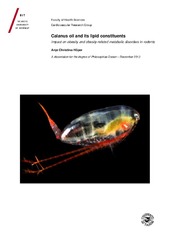Calanus oil and its lipid constituents - Impact on obesity and obesity-related metabolic disorders in rodents
Permanent lenke
https://hdl.handle.net/10037/11284Åpne
Thesis (PDF)
Paper I: Höper, A. C., Salma, W., Khalid, A. M., Hafstad, A. D., Sollie, S. J., Raa, J., Larsen, T. S., Aasum, E.: “Oil from the marine zooplankton Calanus finmarchicus improves the cardiometabolic phenotype of diet-induced obese mice”. Also available in Br J Nutr 2013, 110 (12): 2186-2193. (PDF)
Paper III: Höper, A. C., Larsen, T. S., Fuglesteg, B. N., Khalid, A. M., Tande, K. S., Aasum, E, Pedersen, A. M., Olsen, R. L.: “Chemical composition of Calanus oil and safety assessment based on physiological studies in rats”. (Manuscript). (PDF)
Dato
2014-02-26Type
Doctoral thesisDoktorgradsavhandling
Forfatter
Höper, Anje ChristinaSammendrag
Fedme er et økende helseproblem, og spesielt er avleiring av bukfett forbundet med økt risiko for en rekke sykdommer. Kosttilskudd med omega-3 fettsyrer har vist positive effekter på fedme-relaterte sykdommer. Calanusolje er et relativt nytt produkt som produseres fra raudåte (Calanus finmarchicus) som finnes i store mengder i norske farvann. Oljen har lavt innhold av miljøgifter og er rik på anti-oksidanter og langkjedede mono- og flerumettede fettsyrer. Avhandlingen omhandler fysiologiske effekter av Calanusolje i diett-indusert overvektige gnagere, som er en etablert modell for overvekt hos mennesker.
Gnagere ble foret med vanlig eller fettrik diett. Noen dyr fikk fettrik diett med tilskudd av små mengder Calanusolje eller et ekstrakt av oljen (voksester, som er den dominerende kilden til omega-3 fettsyrer i oljen). Dyrene med fettrik diett utviklet overvekt med betydelig avleiring av bukfett, samtidig som et forstadium av diabetes. I tillegg oppsto det en lavgradsbetennelse i fettvevet (invasjon av betennelsesceller og utskillelse av betennelses-fremmende faktorer). Dyrene som fikk Calanusolje hadde klart mindre bukfett og bedre blodsukkerkontroll sammenlignet med de som fikk fettrik diett alene. Lavgradsbetennelsen ble også kraftig redusert. De samme resultatene ble oppnådd i dyr som fikk voksester i dietten. Det er usikkert hva som forklarer de positive effektene av oljen/voksesteren, men sannsynligvis er det en kombinasjon av flere helse-fremmende fettsyrer. Det er i hvert fall åpenbart at den aktive komponenten i Calanusoljen finnes i voksester-fraksjonen og at oljen er effektiv i svært lave doser. The prevalence of obesity has risen dramatically worldwide and has reached epidemic
proportions. Particularly, visceral or abdominal obesity has been shown to correlate strongly
with a number of pathologies, such as type 2 diabetes mellitus, cardiovascular disease and
stroke. Consumption of fish and marine oils containing omega-3 polyunsaturated fatty acids
(n-3 PUFAs) has been shown to be beneficial in some of these conditions. Oil from the
marine zooplankton Calanus finmarchicus (Calanus oil) has recently emerged as a nutritional
supplement for the human market, and the aim of this thesis was to provide data on the
chemistry, safety issues, as well as on the physiological effects of this oil in obese rodents.
Unlike other n-3 PUFA-rich nutritional supplements, Calanus oil is mainly composed of
monoesters of long-chain fatty acids and fatty alcohols, also called wax esters. In addition, it
is rich in the potent anti-oxidant astaxanthin. The fatty acid moiety of the wax esters includes
high amounts of n-3 PUFAs (EPA, 20:5; DHA, 22:6, stearidonic acid=SDA, 18:4), as well as
monounsaturated fatty acids (MUFAs), such as gondoic (20:1 n-9) and cetoleic acid (22:1 n-
11). Toxicology analysis confirms low levels of heavy metals, organic and non-organic
impurities. Calanus oil supplementation (1.5%, w/w) had no adverse effects during high-fat
feeding in rats or mice. On the contrary, it provided beneficial health effects compared to
animals fed a high-fat diet alone, as demonstrated by (1) reduced body weight gain, (2)
reduced deposition of intra-abdominal fat, (3) reduced adipose tissue inflammation, (4)
reduced hepatic steatosis and (5) improved glucose tolerance. Almost identical effects were
seen after supplementation with Calanus oil-derived wax esters (1%, w/w). Wax ester
supplementation also improved aerobic capacity compared to high-fat diet alone. By
comparison, supplementation with purified EPA+DHA ethyl esters in a concentration
corresponding to the total amount of n-3 PUFAs in the wax ester diet showed primarily antiinflammatory
effects, whereas the impact on obesity and glucose tolerance was only modest.
In summary, Calanus oil as a dietary supplement is well tolerated and exerts beneficial effects
against obesity and obesity-related disorders in rodents. Although the biologically active
components are not identified, they seem to be confined to the main lipid fraction (wax esters)
of the oil. Most likely, its beneficial effects are dependent on an interaction between different
MUFAs and PUFAs, as well as on a rather slow digestion and uptake into the circulation at
the distal part of the intestine. Calanus oil seems to be a good alternative to other n-3 PUFA
containing supplements, but has the advantage of being naturally low in environmental
contaminants and effective in very small amounts.
Beskrivelse
The paper II of this thesis is not available in Munin.
Paper II: Höper, A. C., Salma, W., Sollie, S. J., Hafstad, A. D., Lund, J., Khalid, A. M., Raa, J., Aasum, E., Larsen, T. S.: «Wax esters from the marine copepod Calanus finmarchicus reduce diet-induced obesity and obesity-related metabolic disorders in mice”. (Manuscript). Published version available in J Nutr 2014, 144(2):164-169.
Paper II: Höper, A. C., Salma, W., Sollie, S. J., Hafstad, A. D., Lund, J., Khalid, A. M., Raa, J., Aasum, E., Larsen, T. S.: «Wax esters from the marine copepod Calanus finmarchicus reduce diet-induced obesity and obesity-related metabolic disorders in mice”. (Manuscript). Published version available in J Nutr 2014, 144(2):164-169.
Forlag
UiT The Arctic University of NorwayUiT Norges arktiske universitet
Metadata
Vis full innførselSamlinger
Copyright 2014 The Author(s)
Følgende lisensfil er knyttet til denne innførselen:


 English
English norsk
norsk
